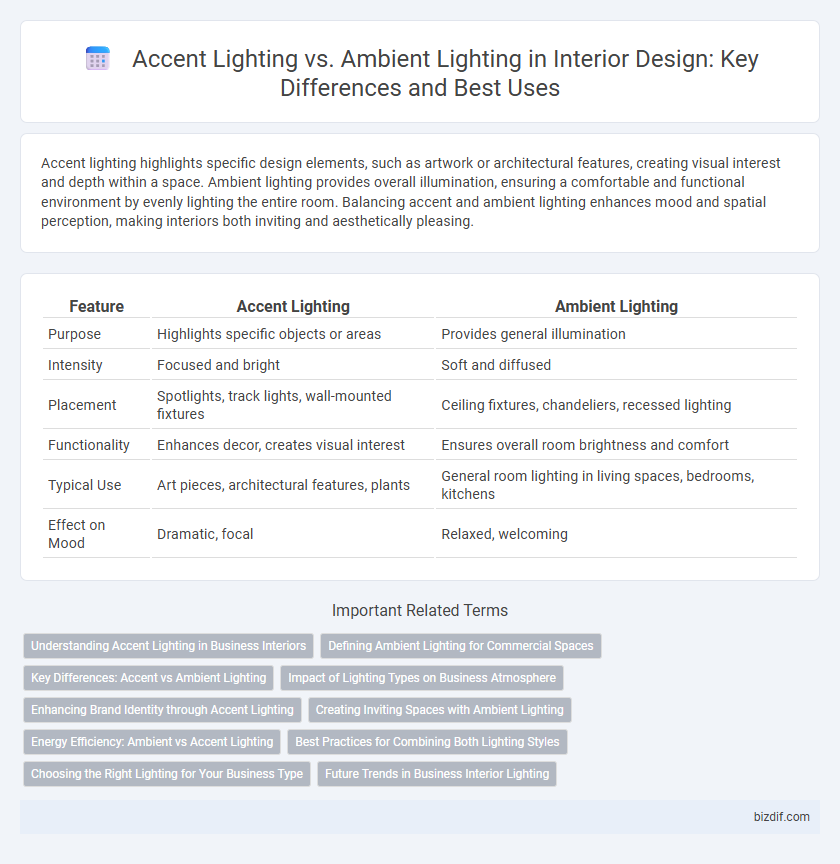Accent lighting highlights specific design elements, such as artwork or architectural features, creating visual interest and depth within a space. Ambient lighting provides overall illumination, ensuring a comfortable and functional environment by evenly lighting the entire room. Balancing accent and ambient lighting enhances mood and spatial perception, making interiors both inviting and aesthetically pleasing.
Table of Comparison
| Feature | Accent Lighting | Ambient Lighting |
|---|---|---|
| Purpose | Highlights specific objects or areas | Provides general illumination |
| Intensity | Focused and bright | Soft and diffused |
| Placement | Spotlights, track lights, wall-mounted fixtures | Ceiling fixtures, chandeliers, recessed lighting |
| Functionality | Enhances decor, creates visual interest | Ensures overall room brightness and comfort |
| Typical Use | Art pieces, architectural features, plants | General room lighting in living spaces, bedrooms, kitchens |
| Effect on Mood | Dramatic, focal | Relaxed, welcoming |
Understanding Accent Lighting in Business Interiors
Accent lighting in business interiors highlights architectural features, artwork, and focal points to create visual interest and guide customer attention. Unlike ambient lighting, which provides general illumination, accent lighting uses directional fixtures such as track lights, wall sconces, and spotlights to enhance specific areas. This targeted approach improves the overall atmosphere, supports brand identity, and encourages customer engagement by emphasizing key design elements.
Defining Ambient Lighting for Commercial Spaces
Ambient lighting in commercial spaces establishes the overall illumination that ensures visibility, safety, and comfort, typically achieved through ceiling fixtures, recessed lights, or wall sconces. It provides a uniform light level that supports general activities without creating glare or harsh shadows, forming the foundational luminance layer in interior design. Effective ambient lighting enhances the spatial perception and mood, making commercial environments inviting and functional for customers and employees alike.
Key Differences: Accent vs Ambient Lighting
Accent lighting emphasizes specific objects or architectural features, creating focal points and adding depth to interior spaces, typically using spotlights or track lights. Ambient lighting provides overall illumination, ensuring comfortable visibility and a uniform light level throughout a room, often achieved with ceiling fixtures or recessed lights. The key difference lies in accent lighting's role in highlighting, while ambient lighting serves as the primary, general light source.
Impact of Lighting Types on Business Atmosphere
Accent lighting highlights specific architectural features or merchandise, creating focal points that draw customer attention and enhance brand identity in retail environments. Ambient lighting provides a uniform level of illumination that sets the overall mood, impacting customer comfort and employee productivity in office spaces. Strategic use of both lighting types influences customer behavior and supports desired business outcomes by balancing visual appeal and functional brightness.
Enhancing Brand Identity through Accent Lighting
Accent lighting in interior design plays a crucial role in enhancing brand identity by highlighting key architectural features, products, or brand elements, creating a memorable visual impact. Unlike ambient lighting, which provides general illumination, accent lighting directs focus and adds depth, reinforcing the brand's aesthetic and emotional appeal. Strategic use of accent lighting elevates customer experience, making spaces more engaging and visually aligned with brand values.
Creating Inviting Spaces with Ambient Lighting
Ambient lighting provides a soft, uniform glow that enhances the overall mood and warmth of a room, making spaces feel inviting and comfortable. Diffused light sources such as ceiling-mounted fixtures, recessed lights, or wall sconces create a balanced illumination that supports relaxation and social interaction. This foundational lighting layer reduces harsh shadows and highlights, setting a cozy atmosphere that accent lighting alone cannot achieve.
Energy Efficiency: Ambient vs Accent Lighting
Ambient lighting provides broad, energy-efficient illumination by using LED or CFL bulbs designed to reduce power consumption across entire rooms. Accent lighting targets specific areas or objects with focused brightness, often requiring multiple fixtures that can increase overall energy use. Selecting energy-efficient bulbs and utilizing dimmers or timers helps optimize power savings in both lighting types for sustainable interior design.
Best Practices for Combining Both Lighting Styles
Accent lighting enhances specific features such as artwork, architectural details, or decorative objects, creating focal points that add depth and interest to interior spaces. Ambient lighting provides uniform illumination essential for overall visibility and comfort, typically achieved through ceiling fixtures, recessed lights, or wall sconces. Combining both lighting styles effectively involves layering light sources, using dimmers to adjust intensity, and selecting complementary color temperatures to balance functionality and aesthetic appeal.
Choosing the Right Lighting for Your Business Type
Accent lighting highlights specific features or products, creating visual interest and guiding customer attention in retail stores, galleries, or hospitality venues. Ambient lighting provides overall illumination, establishing a comfortable and inviting atmosphere essential for offices, restaurants, and healthcare facilities. Selecting the right balance between accent and ambient lighting enhances brand identity and improves functionality based on the business environment.
Future Trends in Business Interior Lighting
Accent lighting enhances focal points and architectural features, creating visual interest and depth in business interiors, while ambient lighting provides uniform illumination for overall comfort and functionality. Future trends emphasize energy-efficient LED technologies integrated with smart controls, allowing customizable lighting scenes that adapt to varying work activities and moods. The shift towards human-centric lighting designs aims to improve employee wellbeing and productivity by mimicking natural daylight cycles and reducing glare.
Accent lighting vs Ambient lighting Infographic

 bizdif.com
bizdif.com